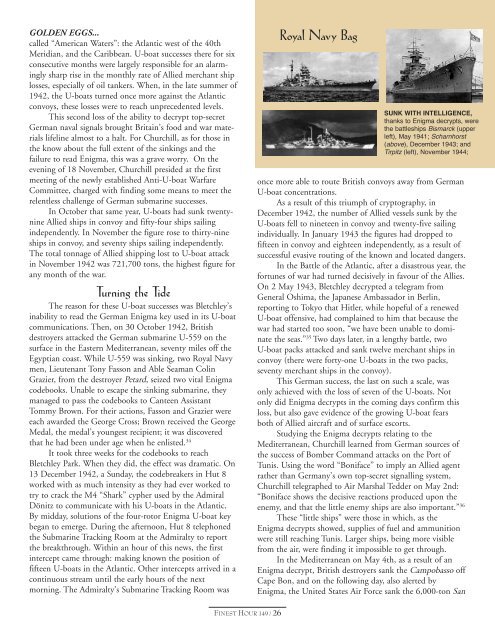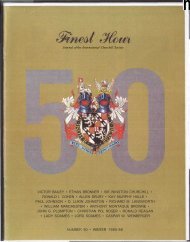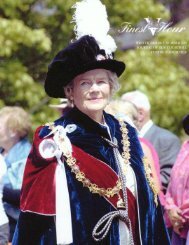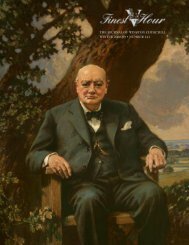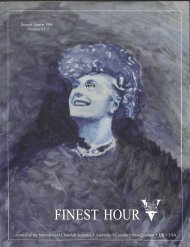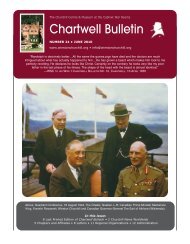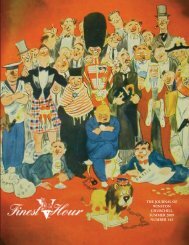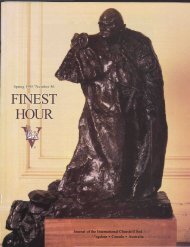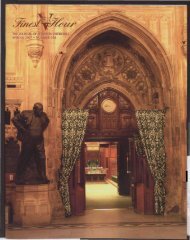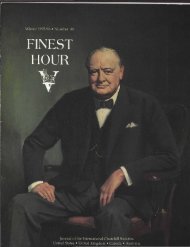GOLDEN EGGS...called “American Waters”: the Atlantic west of the 40thMeridian, and the Caribbean. U-boat successes there for sixconsecutive months were largely responsible for an alarminglysharp rise in the monthly rate of Allied merchant shiplosses, especially of oil tankers. When, in the late summer of1942, the U-boats turned once more against the Atlanticconvoys, these losses were to reach unprecedented levels.This second loss of the ability to decrypt top-secretGerman naval signals brought Britain’s food and war materialslifeline almost to a halt. For <strong>Churchill</strong>, as for those inthe know about the full extent of the sinkings and thefailure to read Enigma, this was a grave worry. On theevening of 18 November, <strong>Churchill</strong> presided at the firstmeeting of the newly established Anti-U-boat WarfareCommittee, charged with finding some means to meet therelentless challenge of German submarine successes.In October that same year, U-boats had sunk twentynineAllied ships in convoy and fifty-four ships sailingindependently. In November the figure rose to thirty-nineships in convoy, and seventy ships sailing independently.The total tonnage of Allied shipping lost to U-boat attackin November 1942 was 721,700 tons, the highest figure forany month of the war.Turning the TideThe reason for these U-boat successes was Bletchley’sinability to read the German Enigma key used in its U-boatcommunications. Then, on 30 October 1942, Britishdestroyers attacked the German submarine U-559 on thesurface in the Eastern Mediterranean, seventy miles off theEgyptian coast. While U-559 was sinking, two Royal Navymen, Lieutenant Tony Fasson and Able Seaman ColinGrazier, from the destroyer Petard, seized two vital Enigmacodebooks. Unable to escape the sinking submarine, theymanaged to pass the codebooks to Canteen AssistantTommy Brown. For their actions, Fasson and Grazier wereeach awarded the George Cross; Brown received the GeorgeMedal, the medal’s youngest recipient; it was discoveredthat he had been under age when he enlisted. 34It took three weeks for the codebooks to reachBletchley Park. When they did, the effect was dramatic. On13 December 1942, a Sunday, the codebreakers in Hut 8worked with as much intensity as they had ever worked totry to crack the M4 “Shark” cypher used by the AdmiralDönitz to communicate with his U-boats in the Atlantic.By midday, solutions of the four-rotor Enigma U-boat keybegan to emerge. During the afternoon, Hut 8 telephonedthe Submarine Tracking Room at the Admiralty to reportthe breakthrough. Within an hour of this news, the firstintercept came through: making known the position offifteen U-boats in the Atlantic. Other intercepts arrived in acontinuous stream until the early hours of the nextmorning. The Admiralty’s Submarine Tracking Room wasRoyal Navy BagSUNK WITH INTELLIGENCE,thanks to Enigma decrypts, werethe battleships Bismarck (upperleft), May 1941; Scharnhorst(above), December 1943; andTirpitz (left), November 1944;once more able to route British convoys away from GermanU-boat concentrations.As a result of this triumph of cryptography, inDecember 1942, the number of Allied vessels sunk by theU-boats fell to nineteen in convoy and twenty-five sailingindividually. In January 1943 the figures had dropped tofifteen in convoy and eighteen independently, as a result ofsuccessful evasive routing of the known and located dangers.In the Battle of the Atlantic, after a disastrous year, thefortunes of war had turned decisively in favour of the Allies.On 2 May 1943, Bletchley decrypted a telegram fromGeneral Oshima, the Japanese Ambassador in Berlin,reporting to Tokyo that Hitler, while hopeful of a renewedU-boat offensive, had complained to him that because thewar had started too soon, “we have been unable to dominatethe seas.” 35 Two days later, in a lengthy battle, twoU-boat packs attacked and sank twelve merchant ships inconvoy (there were forty-one U-boats in the two packs,seventy merchant ships in the convoy).This German success, the last on such a scale, wasonly achieved with the loss of seven of the U-boats. Notonly did Enigma decrypts in the coming days confirm thisloss, but also gave evidence of the growing U-boat fearsboth of Allied aircraft and of surface escorts.Studying the Enigma decrypts relating to theMediterranean, <strong>Churchill</strong> learned from German sources ofthe success of Bomber Command attacks on the Port ofTunis. Using the word “Boniface” to imply an Allied agentrather than Germany’s own top-secret signalling system,<strong>Churchill</strong> telegraphed to Air Marshal Tedder on May 2nd:“Boniface shows the decisive reactions produced upon theenemy, and that the little enemy ships are also important.” 36These “little ships” were those in which, as theEnigma decrypts showed, supplies of fuel and ammunitionwere still reaching Tunis. Larger ships, being more visiblefrom the air, were finding it impossible to get through.In the Mediterranean on May 4th, as a result of anEnigma decrypt, British destroyers sank the Campobasso offCape Bon, and on the following day, also alerted byEnigma, the United States Air Force sank the 6,000-ton SanFINEST HOUR 149 / 26
Antonio: the last large merchant ships to try to reach Tunis.As <strong>Churchill</strong> had foreseen, the Germans continued to try touse smaller craft, and even planned—as one Enigmadecrypt showed on May 6th—to use U-boats to ferry fuel.On July 8th, <strong>Churchill</strong> was able to telegraph to Stalinthat in seventy days, fifty U-boats had been sunk. 37 On the14th, he reported to Roosevelt that seven U-boats had beensunk in thirty-six hours, “the record killing of U-boats yetachieved in so short a time.” 38 Guided by Enigma, theBattle of the Atlantic had been won by the Allies. SixtyBritish merchant ships had been sunk in March, thirty-fourin April, thirty-one in May and eleven in June; the Junefigure confirmed that it was safe to release warships andmerchant ships for all theatres of war, including the landingsin Sicily, Italy and Normandy.<strong>Churchill</strong> could offset the few failures at sea withmany successes. Enigma helped to seal the fate of theGerman battleship Bismarck in May 1941, when 2300German sailors perished, and the battle cruiser Scharnhorstin December 1943, when 1995 of her crew of 2200 werekilled. 39 Another naval challenge, the attempt to destroy theGerman battleship Tirpitz—the largest battleship ever builtin Europe—as she sheltered in Norwegian waters, wasreflected in many German Air Force Enigma messages: one,in April 1942, revealed German appreciation of a “mostcourageous” but ineffective attack that month by BomberCommand. 40 Enigma played its part in the final, successfulattack on Tirpitz by Bomber Command on 12 November1944, when the pride of the German Navy capsized, and1000 of her crew of 1700 were drowned. ,1. War Office papers, WO 199/911A.2. “German Preparations for Invasion”, 4 and 9 October 1940, WarOffice papers, WO 199/911A.3. “Officer Only.” “Most Secret.” “Invasion of Britain,” MI14, 12January 1941: War Office papers, WO 119/911A.4. Secret Intelligence Service papers, series HW1.5. Minute of 16 October 1940: <strong>Churchill</strong> papers, 20/13.6. Letter of 22 September 1941: Secret Intelligence Service papers,HW1/86.7. John Colville, diary entry, 4 May 1941: Colville papers.8. John Martin papers and conversation with Martin Gilbert, 1979.9. “Secret and Confidential.” “Prime Minister Only.” 21 October 1941:Hinsley and others, British Intelligence in the Second World War, volume 2,(HMSO: London 1981), 655.10. “Action This Day.” Hinsley and others, 657.11. Dir/C Archives, No. 2592: Hinsley and others, 647.12. Ralph Erskine and Peter Freeman, “Brigadier John Tiltman: One ofBritain”s finest cryptographers,” Cryptologia, Volume 27, Issue 4, October 2003.13. <strong>Churchill</strong>’s comments on the Enigma decrypts are in the SecretIntelligence Service papers, reference HW1.14. Office of Chief of Naval Operations (OPNAV): 20th Division of theOffice of Naval Communications, G Section/Communications Security, was theU.S. Navy signals intelligence and cryptanalysis group during World War II. Itsmission was to intercept, decrypt, and analyze naval communications fromJapanese, German, and Italian navies. In addition, OP-20-G copied diplomaticmessages of many foreign governments. Its branches included G-30 (PacificTheater), G-40 (Atlantic Theatre), G-70 (Clandestine), G-80 (StrategicInformation Coordination), GI-A (Correlation and Dissemination, Atlantic),GI-D (Correlation and Dissemination, Diplomatic), GI-P (Correlation andDissemination, Pacific), GT (traffic analysis) and GY (cryptanalysis).15. “Most Secret.” 8 February 1942: <strong>Churchill</strong> papers, 20/52.16. U.S. National Security Agency, Central Security Service, “Solving theEnigma”: http://www.nsa.gov/publications/publi00016.cfm.17. Stephen Ambrose, Ike’s Spies (Jackson, Mississippi: University Pressof Mississippi, 1981), chapter 1.18. Bradley F. Smith, The Ultra-Magic Deals and the Most Secret SpecialRelationship 1940-1946 (New York: Presidio, 1993), 153.19. The complete text of BRUSA was kept secret until November 1995,fifty years after the end of the war. It was published in full by John Cary Sims,“The BRUSA Agreement of May 17, 1943,” Cryptologia, Volume 21, Issue 1,January 1997.Endnotes20. Ralph Erskine and Peter Freeman, “Brigadier John Tiltman: One ofBritain’s Finest Cryptographers,” Cryptologia, Volume 27, Issue 4, October2003.21. Decrypt CX/JQ 417, 1 November 1940, revealed German plans toinstall aircraft warning systems in Romania and Bulgaria.22. War Cabinet Paper No. 431 of 1940, 5 November 1940, “Possibilityof Enemy Advance through the Balkans and Syria.” Cabinet papers, 70/1.23. Defence Committee (Operations), 8 January 1941: Cabinet papers,69/2.24. Telegram of 11 January 1941: <strong>Churchill</strong> papers, 20/49.25. F.H. Hinsley and others, British Intelligence in the Second WorldWar, Its Influence on Strategy and Operations, (HMSO: London, 1979), I: 353.26. Decrypt CX/JQ 603.27. Decrypt CX/JQ 605.28. Telegram of 28 April 1941, telephoned to Downing Street on a secureline from Chequers: Premier papers, 3/109.29. “Most Secret” minute of 10 May 1941: Premier papers, 3/109.30. Enigma decrypt CX/MSS/205/T2 of 3 September 1941.31. 3 September 1941: SIS papers, HW1/43.32. Prime Minister’s Personal Telegram No.257 of 1942, 16 February1942: <strong>Churchill</strong> papers, 20/70.33. For details of the ten Enigma machines recovered at sea see “TheCapture of German Enigma Machines and Codebooks, 12 February 1940 - 4June 1944” in Martin Gilbert, Atlas of the Second World War (New York:Routledge, 2008), Map 204.34. Tommy Brown died later in the war, in Britain, trying to rescue histwo sisters from a burning building.35. Secret Intelligence Service archive, series HW1.36. “Personal,” “Most Secret,” Prime Minister’s Personal Telegram No.630 of 1943, 2 May 1943: <strong>Churchill</strong> papers 20/111.37. “Personal and Most Secret,” Prime Minister’s Personal Telegram No.975 of 1943, 8 July 1943: <strong>Churchill</strong> papers, 20/114.38. “Personal and Secret,” Prime Minister’s Personal Telegram No.1031/3 of 1943, 14 July 1943: <strong>Churchill</strong> papers, 20/115.39. “Sink the Bismarck” was <strong>Churchill</strong>’s instruction following thesinking of the British battle cruiser Hood by Bismarck on 24 March 1941, with1415 deaths (and only three survivors). During the sinking of Scharnhorstthree days later, the Staff Officer (Intelligence) on board the battleship Duke ofYork was Edward Thomas, later one of the historians of British SignalsIntelligence.40. Decrypt 0011 of 29 April 1942.FINEST HOUR 149 / 27


